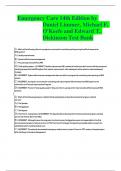Exam (elaborations)
Test Bank for Emergency Care 14th Edition by Daniel Limmer, Michael F. O'Keefe and Edward T. Dickinson, A+ guide | All Chapters Covered
- Course
- Institution
- Book
Emergency Care 14th Edition by Daniel Limmer, Michael F. O'Keefe and Edward T. Dickinson Test Bank Table of Contents SECTION 1: FOUNDATIONS 1. Introduction to Emergency Medical Care 2. Well-Being of the EMT 3. Lifting and Moving Patients 4. Medical, Legal, and Ethical Issues 5. Medical Terminology ...
[Show more]



